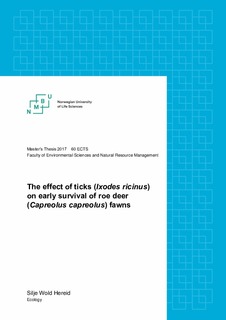| dc.description.abstract | Parasites can be a burden for many animals and may in some cases affect the survival and reproduction of their hosts. The effect ticks may have on the early survival of roe deer (Capreolus capreolus) fawns is less known. Knowing what affects mortality of neonatal roe deer is important to estimate reproduction and growth potential in populations. A total of 213 roe deer fawns were captured in Sweden at two different study sites (Bogesund and Grimsö). Fawns were sampled for ticks (Ixodes ricinus) at initial capture and at recaptures during the first 30 days after birth. I first investigated variation in tick burden between individuals, and if ticks induced a physiological response in roe deer fawns (i.e., a body temperature increase). Thereafter I tested if ticks affected early survival using Cox Proportional Hazard models.
The number of ticks on fawns below the age of 30 days was generally low, where 45% of total observations (n = 552) had 10 ticks or less, and 9% of observations had no ticks attached at all. Number of ticks increased with increasing age and body mass. Body temperature increased significantly with increasing number of ticks attached to the fawn, demonstrating a physiological response to tick attachments.
A total of 68 out of the 213 fawns died within their first 30 days (32%). Of total mortality, 6% died from unknown causes, 16% died from natural causes and 78% died from predation. In the univariate Cox Proportional Hazard models, number of ticks and body temperature had no effect on survival. Further, the univariate models showed that fawn mortality increased over time, where risk of dying increased with age in the first 30 days, indicating that mortality is high in the first month after birth. In addition, habitat had an effect on survival, where the risk of dying increased in open field habitat compared to forest. When separating study sites, fawns with a higher body mass than expected for their age were found to have a decreased risk of dying at Bogesund, whereas neither individual traits nor habitat characteristics at capture sites were found to affect survival in Grimsö. Fawns that died from predation also had a higher risk of dying in open field habitat, while fawns that died from natural causes had a decreased risk of dying with higher body mass.
Low amount of ticks on young fawns may relate to the hiding behaviour in the first period after birth, and higher activity level and more exposure to questing ticks is considered to be the main reason for the tick increase as the fawn gets older and heavier. The increase in body temperature caused by ticks may indicate a fever response to pathogens associated with ticks. However, neither amount of ticks nor body temperature had any effect on survival of the fawn. The effect of ticks might be disguised in populations with high mortality rates. It is recommended to further investigate the effect of ticks on the survival of roe deer fawns along a predation pressure and tick abundance gradient, in addition to the effect of tick-borne pathogens that were not addressed in this study. | nb_NO |

